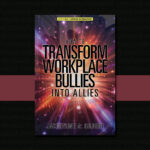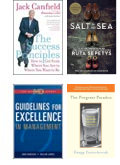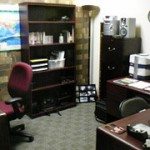A beautifully appointed office begins with a clutter free work area. Howard (2010) explains that the four steps to successful organization are plan and empty, sort, shop, and reassemble. To streamline your workspace, routinely shred or recycle documents once they have outlived their usefulness, and begin each semester with a fresh plate. Anything that isn’t used on a regular basis (e.g., stapler, hole puncher, stationery) should be stored out of sight.
Within desk drawers store smaller items (inside organizer trays) and larger ones inside wire mesh or plastic containers. Because spaces like pen holders, desk drawers, and open shelves can be magnets for discarded and unused items, each of these areas should undergo a ruthless housecleaning (at least annually) to unearth the tools that are truly essential to your success. Make a concerted effort every day to do one thing that will reduce the mayhem in your personal workspace – this can be as simple as sorting through one drawer or a single file folder. Once you have gained momentum, it becomes easier to reorder your workspace. This process takes effort upfront, but the rewards in terms of peace of mind pay off handsomely down the road.
Maintain the bare minimum of elements on your desk top, relegating the remainder to the confines within desk drawers. To further “declutter” the space in front of you, use a flat screen monitor, and if possible, one that has built in speakers. The newer monitors (like Dell’s flat panel model 1908) allow for convenient access to jump drives (located on the left side). A wireless mouse circumvents that need for a space taking “mouse holder,” and permits more flexible, unrestricted hand movements. To the right of the monitor I have a standing wire file holder, which contains the files that I use most frequently. These include:
- office stationery;
- a “to do” or “pending” file with a prioritized agenda of projects that I wish to accomplish (I staple some inspirational quotes posted on the inside flaps);
- a folder for each course I’m teaching in a semester
Many of the items that clutter your desk can be hung on a wall in tidy receptacles; examples include:
- magazine organizers – see StacksandStacks.com for wall hanging devices
- corkboards that display pictures, postcards, and office flyers
- magnetic information that can be displayed on the side of credenzas
In an office “less is more,” which means that erring on the side of tasteful decor requires a regular cleaning. Vacuum the floors, remove the arachnids, and dust around the wall units on a regular basis. To enhance your sense of well-being, any items that look second rate or shabby should be removed from your office, discarded, or refurbished. Clean screams volumes, and with janitorial staff facing the budgetary chopping block, much of office housekeeping may in the future be your responsibility. In the spirit of office decorum purchase a clean rag and can of furniture polish, and routinely polish/clean your desk surfaces, window ledges, credenza top, and bookshelves.
Have office maintenance fix anything in your space which needs repair or paint, and ensure that your thermostat is working properly. Remove personal things from the office that could be better used at home, unpackage unopened software programs, and gift unused items to the departmental office or to other colleagues. The simple act of returning books and borrowed things can free an enormous amount of space within your work area. Rearranging, or better yet “grouping by function” creates even more room, and a series of “visual containers.” The concept of regrouping like items makes them more “findable,” eliminating wasteful searching and double purchasing.
Consider engaging in a clutter preemptive strike: for example, if you regularly return desk copies, contact the respective book publishers and ask to be placed on their “do not contact list.” In addition: cancel unneeded subscriptions, club memberships, committee assignments, magazines, and newsletters; pare down unnecessary activities that distract you from what is your highest priority.
______________________________________________________________________________________________
References
Howard, S. (2010). From cluttered to clean: the art of organizing. Better Homes and Gardens Special Interest Publications, 13-14.





Recent Comments